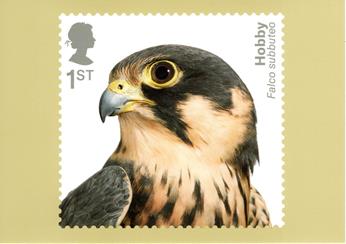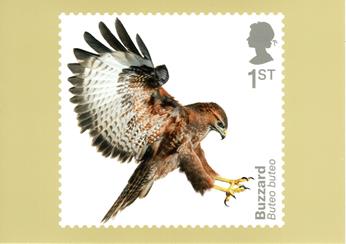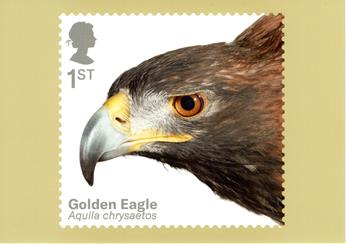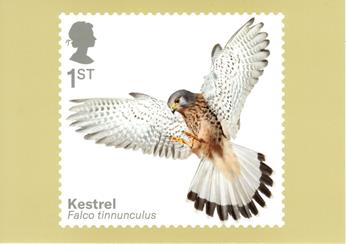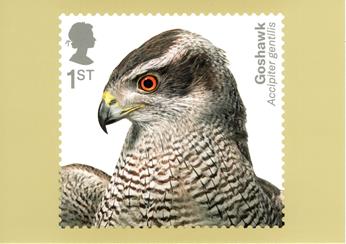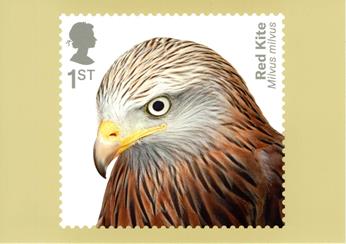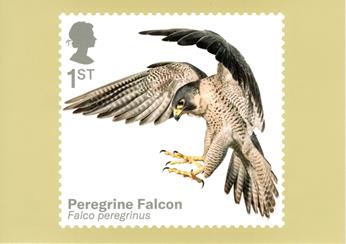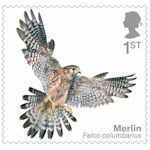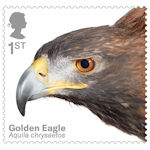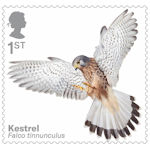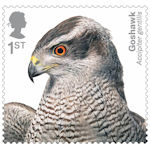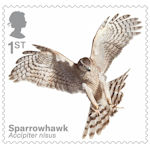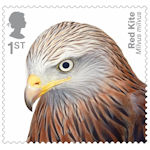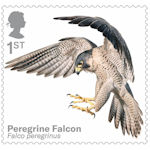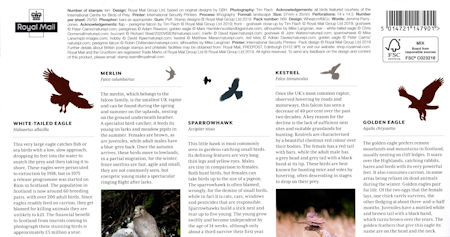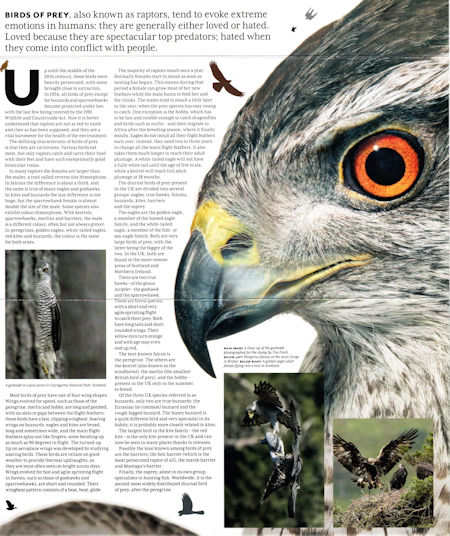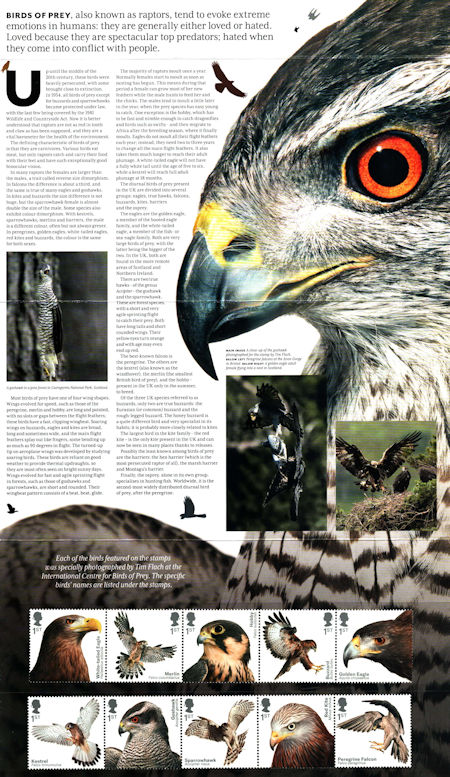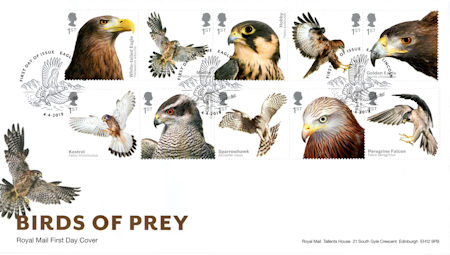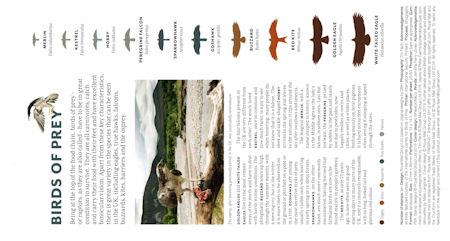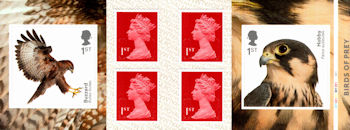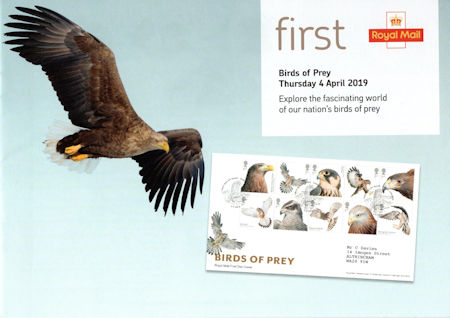Birds of Prey
 Birds of Prey at Royal Mail
Birds of Prey at Royal Mail
2019 (April 4 2019)
Commemorative
Size 37mm (h) x 35mm (v)
Printed by International Security Printers
Print Process Lithography
Perforations 14 x 14.5
Gum PVA
Stamps
White-tailed Eagle
1stThis very large eagle catches fish or sea birds with a low, slow approach, dropping its feet into the water to snatch the prey and then taking it to shore. These eagles were persecuted to extinction by 1918, but in 1975 a release programme was started on Rùm in Scotland. The population in Scotland is now around 60 breeding pairs, with over 200 adult birds. Since eagles readily feed on carrion, they get blamed for killing animals they are unlikely to kill. The financial benefit to Scotland from tourists coming to photograph these stunning birds is approximately £5 million a year.
Merlin
1stThe merlin, which belongs to the falcon family, is the smallest UK raptor and can be found during the spring and summer on the uplands, nesting on the ground underneath heather. A specialist bird-catcher, it feeds its young on larks and meadow pipits in the summer. Females are brown, as are juveniles, while adult males have a blue-grey back. Once the autumn arrives, these birds move to lowlands, in a partial migration, for the winter. Since merlins are fast, agile and small, they are not commonly seen, but energetic young make a spectacular ringing flight after larks.
Hobby
1stLarger than the merlin, this little falcon migrates to the UK from Africa in the spring to breed. With its long, sickle-shaped wings, it resembles a giant swift and is incredibly nimble in flight. Feeding on dragonflies and other insects, the hobby is often seen near large bodies of water. It nests using abandoned crows’ nests, and during the breeding season it hunts for swallows and swifts to feed its young. Once the young are able to fly and can hunt for themselves, hobbies migrate with the swallows back to Africa.
Buzzard
1stBy the 1970s, the common (or Eurasian) buzzard was rare in the UK other than in the far west. Since then, however, there has been a huge increase thanks to more nesting areas and to rabbits surviving myxomatosis, and buzzards are now breeding in every county. Buzzards are usually seen on fi ne days soaring and calling, with a mewing cry, or sitting on poles, on fences by roads or on the ground, particularly when ploughed in the winter. They scavenge roadkill, which can cause them traffic injuries, or feed on insects on the ground. There is enormous colour variation in this species, from almost all cream to very dark brown.
Golden Eagle
1stThe golden eagle prefers remote moorlands and mountains in Scotland, usually nesting on cliff ledges. It soars over the Highlands, catching rabbits, hares and birds with its very powerful feet. It also consumes carrion, in some areas being reliant on dead animals during the winter. Golden eagles pair for life. Of the two eggs that the female lays, one chick rarely survives, the other fl edging at about three-and-a-half months. Juveniles have a mottled white and brown tail with a black band, which turns brown over the years. The golden feathers that give this eagle its name are on the head and the neck.
Kestrel
1stOnce the UK’s most common raptor, observed hovering by roads and motorways, this falcon has seen a decrease of 40 per cent over the past two decades. A key reason for the decline is the lack of sufficient nest sites and suitable grasslands for hunting. Kestrels are characterised by a beautiful chestnut-red colour over their bodies. The female has a red tail with bars, while the adult male has a grey head and grey tail with a black band at its tip. These birds are best known for hunting mice and voles by hovering, often descending in stages to drop on their prey.
Goshawk
1stThis aggressive, forest-dwelling hunter was probably extinct as a breeder until the middle of the 20th century. Its wing shape allows it to twist and turn through trees, and its long legs and powerful feet are well suited to hunting birds and mammals up to the size of a hare, with a short, often surprise attack. Adults are grey and white, with fi ne horizontal bars on the breast, while juveniles are brown, with vertical brown stripes. Goshawks build large stick nests and lay up to four eggs. The parents are vocal in the spring, when they can sometimes be seen soaring high in good weather.
Sparrowhawk
1stThis little hawk is most commonly seen in gardens catching small birds. Its defining features are very long, thin legs and yellow eyes. Males are tiny in comparison to females. Both hunt birds, but females can take birds up to the size of a pigeon. The sparrowhawk is often blamed, wrongly, for the demise of small birds, while in fact it is cats, cars, windows and pesticides that are responsible. Sparrowhawks build a stick nest and rear up to five young. The young grow swiftly and become independent by the age of 14 weeks, although onlyabout a third survive their first year.
Red-Kite
1stBy 1903, red kites had been persecuted close to extinction, with the last few remaining in the mountains of Wales, when a farmer started to feed them. Now, with four feeding stations, there are 900 pairs in Wales. There have been very successful translocation programmes in England, Scotland and Northern Ireland, so kites are now seen soaring together in many places. Long wings, a long, forked tail and red colour make the red kite easy to identify. These birds are mainly scavengers, feeding on roadkill and animal remains. They have small feet for their body size, which limits the prey they can catch.
Peregrine Falcon
1stBrought to low numbers by pesticides in the middle of the 20th century, the peregrine has recovered dramatically. Many peregrines are now urban birds, nesting on cathedrals, other tall buildings and bridges. Probably the fastest living creature, the peregrine hunts birds up to the size of large gulls, almost always on the wing. It has a short tail and long, pointed wings. The juveniles are brown, while the adults have a grey-blue back. In the UK, these birds are sedentary, but peregrines in other areas can be migratory, and they are the most widely spread raptors worldwide.
PHQ Cards


